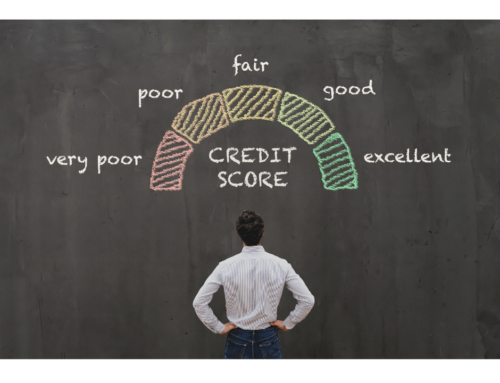Before lenders decide to lend you money, they need to know if you’re willing and able to repay the loan. To calculate your ability to repay, lenders look at your debt-to-income ratio. To assess your willingness to repay, they use your credit score.
The most commonly used credit scores are FICO scores, developed by the financial analytics agency Fair Isaac & Company. FICO scores range from 350 (very high risk) to 850 (low risk). You can find out more on FICO here.
Credit scores only assess the info in your credit profile. They don’t consider income or personal characteristics. Fair Isaac invented FICO specifically to exclude demographic factors. Credit scoring was developed to assess willingness to pay while specifically excluding other personal factors.
Your current debt level, past late payments, length of your credit history, and other factors are considered. Your score is calculated with positive and negative items in your credit report. Late payments count against you, but a record of paying on time will raise it.
For the agencies to calculate a credit score, you must have an active credit account with a payment history of six months. This history ensures that there is enough information in your report to calculate an accurate score. If you don’t meet the minimum criteria for getting a credit score, you may need to work on a credit history prior to applying for a mortgage loan.
How are FICO Credit Scores Calculated?
Since we live in an computer-driven world, it’s not surprising that your ability to repay your mortgage comes down to a single number. Your FICO score is built by credit agencies. These agencies use the payment history from all of your loans: mortgages, car/motorcycle loans, credit cards, and others.
The three credit reporting agencies use slightly different formulas to build a credit score. The original FICO score was developed by Fair Isaac and Company. While Experian still calls its score “FICO”, TransUnion calls its score “Beacon” and Equifax uses “Empirica.” While their methods vary, all of the agencies use the following to build a credit score:
- Your Credit History – How long have you had credit?
- History of Payments – Do you pay your bills on time?
- Your Credit Card Balances – How many accounts? How much do you owe?
- Credit Inquiries – How many times have you had your credit checked for a loan?
These factors are weighted slightly differently depending on the formula being used. The result is one number. FICO scores range from 300 to 800. Higher is better. Most home buyers in the current environment have a score above 620.
Not just for qualifying
Did you know? FICO scores affect more than your ability to get a loan. They also affect your interest rate. Lenders give lower interest rates to individuals with higher scores.
Improving your FICO score
What can you do to improve your FICO score? Very little in the short term. Despite what you hear from “credit repair” companies, the score is based on your lifelong credit history, so it’s not possible to raise it significantly in the short term. You must, of course, appeal for the credit agency to remove any incorrect reporting on your credit report, which is the only “quick fix” for credit problems.
How do I find out my FICO score?
To raise your FICO score, you must obtain the reports that are used to build it. Of course, you need the score as well. Fair Isaac has created a web site (www.myFICO.com) that lets you do just that. It’s inexpensive, fast, and easy to get your credit score as well as credit reports from all three agencies. Also available are information and tools that help you improve your credit score.
You can get a federally-mandated free credit report every year from all three credit reporting agencies by visiting AnnualCreditReport.com. You won’t get a free credit score from AnnualCreditReport.com, but getting one is quick and very inexpensive.
Armed with this information, you will be a more informed consumer and you’ll be better positioned to obtain the right mortgage for you.
Can I improve my credit score?
It’s virtually impossible to change your score in the time between when most people decide to buy a home or refinance their mortgage and when they apply. So the short answer is, you really can’t change your score “on the spot.” But there are strategies you can live with to make sure that when you apply for a loan your score is as high as possible.
Make sure that the information each of the three credit reporting bureaus has on you is consistent and up to date. Order a copy of your credit report about once a year, and dispute any inaccuracies.
Note: Theoretically, if a series of credit reports is requested on your behalf during a limited amount of time, your score goes down until time passes without any inquiries. Changes in the law though have made “consumer-originating” credit report requests not count so much. Also, a series of requests in relation to getting a mortgage or car loan is not treated the same as a number of credit card requests in a limited time. This is because the credit bureaus, and lenders, realize that people request their own credit reports to keep up with what’s on them, and smart consumers shop around for the best mortgage and car loans.
Unsolicited credit card solicitations in the mail don’t count against your credit report, so don’t worry.
The two main components of your credit score are your payment history and the amounts you owe. Bankruptcy filings and foreclosures, which can stay on your credit report for as long as 10 years, can significantly lower your score. It’s never a good idea to take on more credit than you can handle.
Late payments work against you. It’s extremely important to pay bills on time, even if it’s only the monthly payment.
Don’t “max out” your credit lines. Since the size of the balance on your open accounts is a factor, lower balances are better.
It’s said that by carefully managing your credit, it’s possible to add as much as 50 points per year to your score.



